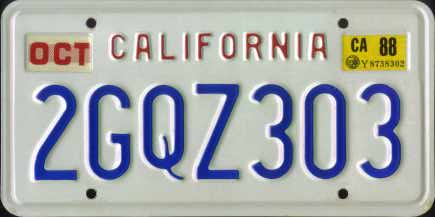
Image from http://www.15q.net/ca.html
In the 1980s, it became practical to make license plates coated in retroreflective microbeads. Retroreflection makes a license plate much easier to read at night. To accomplish this feat, the background color of the plate had to be pure white, and the lettering had to be a darker non-retroreflective color in the shape of the letters or numbers you wanted to be readable at night. At the end of 1987, California state law made it mandatory for all license plates issued to have a retroreflective coating.
While the California sunset design did have a white background (or something close to white, at least), the law required not only the license number, but also the name of the state, to be readable at night under retroreflection. The California sunset logo, with its light-brown striping and sun, didn't allow the name of the state to be read at night, no matter how innovative the artists were with their placement of the retroreflective coating. So instead, California returned to the older "CALIFORNIA" stamped in raised letters that had been used during the black and blue license plate eras, except colored red instead of blue or yellow. The letters and numeric digits of the license number remained the same blue used for the California sunset plates. The words "The Golden State" did not appear at the bottom of the plate, like they did for the California sunset plate.
This change also resulted in a cost savings of four whole cents per license plate.
Standard white-with-California-in-block-printing plates issued for passenger cars had license numbers that continued the pattern in use by the California sunset plates. That is, they consisted of a single numeric digit (starting with 2), followed by 3 letters, followed by 3 numeric digits. No half-space was used between any of these characters. As before, the 3 digit group was incremented first, then when they wrapped back around to zeroes the letters were incremented, then when the letters wrapped back around to A's the first numeric digit was incremented.

Image from
http://www.15q.net/ca.html
Standard white-with-California-in-block-printing plates issued for commercial vehicles continued the license plate number pattern that had been in use by the California sunset plates. That is, they consisted of a single numeric digit, followed by a single letter, followed by 5 numeric digits. No half-space was used between any of these characters. As before, the 3 digit group was incremented first, then when they wrapped back around to zeroes the letter was incremented, then when the letter wrapped back around to A the first digit was incremented.
Starting in this era, commercial plates beginning with 9 were reserved for, and issued to, big-rig tractor units.
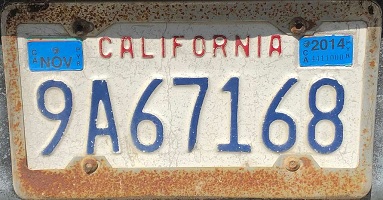
White-with-California-in-block-printing trailer plates continued to follow the pattern of the California sunset trailer plates, with a 1 followed by two letters followed by four numeric digits.
Commercial vehicles can pay rather hefty registration fees. When a commercial vehicle is operated both in California and in one or more other states, it can opt to divide its registration fees among the states it operates in, in proportion to how much time or travelling distance it spends in each state. Such vehicles are issued an apportioned license plate by their "home" state. California began issuing these in 1982 (during the blue license plate era), and continued the practice into the white plate eras. Of note is the fact that only one sticker well is present in the apportioned plates of this era; where the well for the month sticker would normally appear (in the upper left), these plates just have the word CAL in block lettering.
In 1987, these plates began to be produced with blue license numbers on a retroreflective white background. Initially, the "CAL APPORTIONED" logo at the top appeared in red block lettering. However, at some point — perhaps coinciding with the time that other California plates began to appear with "California" in trendy red script — this logo switched to blue block lettering.
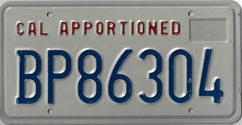
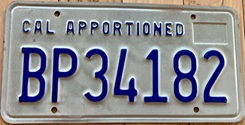
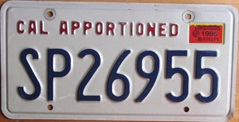
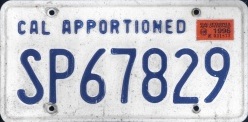
License numbers for these plates consist of 2 letters followed by 5 digits. Not all two-letter combinations are used.
During the white-with-California-in-block-printing license plate era, exempt plates continued to be indicated by an "E" on the left side of the plate inside an octagon or a diamond — octagon for local governments, diamond for the state government.
The license numbers for these plates consisted entirely of six numeric digits, continuing the pattern from the black, blue, and sunset license plate eras.
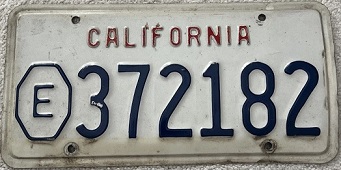

Send comments about this webpage to: rogermw@ix.netcom.com.
Go back to my main license plate index page.
Go back to Roger M. Wilcox's homepage.